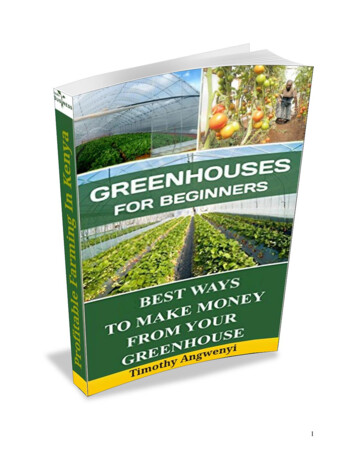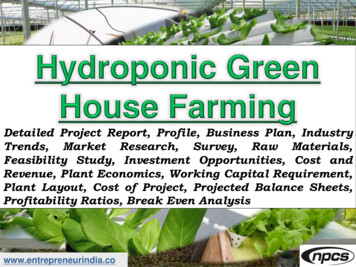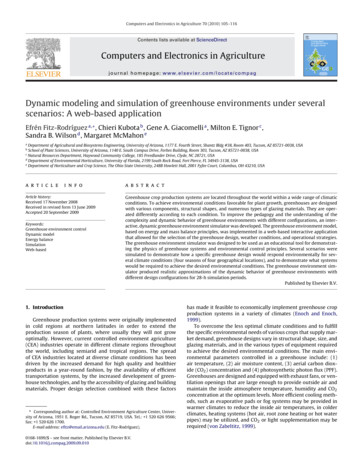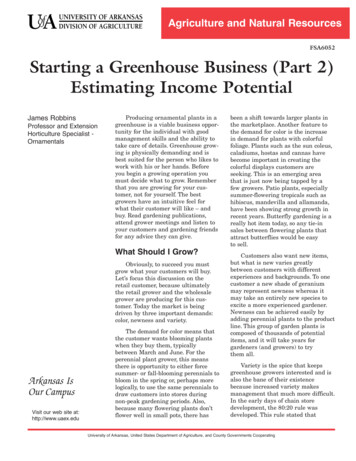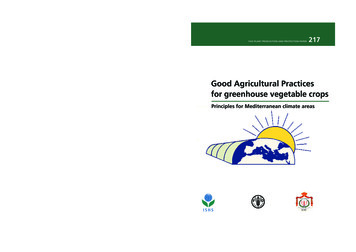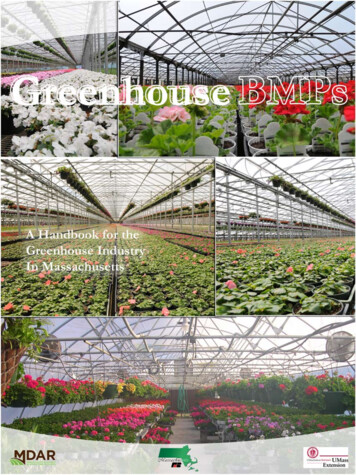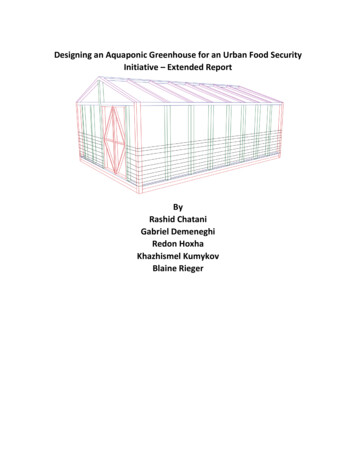
Transcription
Designing an Aquaponic Greenhouse for an Urban Food SecurityInitiative – Extended ReportByRashid ChataniGabriel DemeneghiRedon HoxhaKhazhismel KumykovBlaine Rieger
Designing an Aquaponic Greenhouse for an Urban Food SecurityInitiative – Extended ReportAn Interactive Qualifying Projectsubmitted to the Faculty ofWORCESTER POLYTECHNIC INSTITUTEin partial fulfilment of the requirements for thedegree of Bachelor of ScienceByRashid ChataniGabriel DemeneghiRedon HoxhaKhazhismel KumykovBlaine RiegerDate:30 April 2015Report Submitted to:Matt FeinsteinWorcester Roots ProjectProfessors Stephen McCauley and Lorraine HigginsWorcester Polytechnic InstituteThis report represents work of WPI undergraduate students submitted to the faculty as evidence of adegree requirement. WPI routinely publishes these reports on its web site without editorial or peerreview. For more information about the projects program at WPI, seehttp://www.wpi.edu/Academics/Projects.
AbstractThis project supported the Worcester Roots Project’s effort to build an aquaponic greenhouse at StoneSoup Community Center by designing a greenhouse and prototyping a modular aquaponic growingsystem. The team collaborated with Worcester Roots and Technocopia to develop a vision for thegreenhouse project, evaluate options and determine appropriate designs for the system. We proposed adesign for a wooden greenhouse with several growing systems using cheap, readily available materials,and successfully built a prototype growing system that to be by a future cooperative incubated byWorcester Roots. This project will enable growing local, fresh food in the City of Worcester and providea starting point for developing a cooperative food business.iii
AcknowledgementsWe would like to thank Professor Stephen McCauley and Professor Lorraine Higgins for their constantsupport and guidance throughout this project.We would like to thank Professor Alamo for his assistance with the greenhouse design.We would like to thank everyone at the Worcester Roots Project for their help, encouragement, andcooperation throughout this project.We would also like to thank Technocopia and their volunteer members for assisting us with use of theirworkshop during construction.We would like to thank Amanda Barker and Jonathan Bates for showing us around their greenhouses.iv
AuthorshipRashid Chatani investigated the aquaponic cycle and what plants and fish would work best in such asystem. He developed the base ratios that were used to develop the rest of the design. He also authoredbackground sections regarding aquaponics and its benefits, as well as sections regarding our partners.Gabriel Demeneghi investigated possible designs and components for a greenhouse and created ourfinal greenhouse design. He authored all sections regarding such topics.Redon Hoxha investigated components for the aquaponic system, in particular plumbing, piping, andheating. As well, he investigated heating for the greenhouse structure. He authored all sectionsregarding such topics.Khazhismel Kumykov investigated the market for aquaponics, and also investigated fish tank solutions.He authored the relevant sections. He also was the primary author of the abstract and was the mainformatting editor for the paper.Blaine Rieger investigated solutions for the plant bed design in our system, including possible growingmedia, and bed designs, and authored relevant sections.v
Table of ContentsAbstract.iiiAcknowledgements .ivAuthorship. vTable of Contents .viTable of Tables . ixTable of Figures. ixTable of Equations .xExecutive Summary . xiI.iIntroduction . xiI.iiAquaponic Growing Systems and their Potential to Contribute to Urban Food Security . xiiI.iiiMethods . xiiiI.ivAssessing the Stakeholder’s Needs . xivUnderstanding Aquaponic Greenhouse Systems and Evaluating Design Options . xivDesigning the Greenhouse System . xvBuilding Out Prototype Aquaponic Growing System . xviFindings . xviI.vStakeholder’s Needs . xviDesign Considerations . xviProposed Aquaponic Greenhouse Design . xxiI.viThe Greenhouse Structure . xxiThe Aquaponic Growing System. xxiiiOperating Schedule . xxviThe Prototype Aquaponic System . xxviiConclusion and Recommendations . xxviiiChapter 1Introduction . 1Chapter 2Background . 32.1Food Security and Urban Food Production . 32.1.1Urban Food Production . 32.1.2Food Production in and around Worcester . 52.2Aquaponics as an Approach to Urban Food Production . 52.2.1Biological & Nutrient Cycles in Aquaponic Systems . 72.2.2Benefits of Aquaponics. 72.2.3How common is Aquaponics in the United States and the North East? . 82.2.4Markets in the United States. 82.2.5The Greenhouse Initiative . 92.3Aquaponic Greenhouse Design . 102.3.1Greenhouse Structure . 10vi
2.3.22.3.3Chapter 3Aquaponic System Structural Components . 22Composition of Fish and Crops in Aquaponics . 35Methodology . 383.1Assessing Stakeholder’s Needs . 383.2Understanding Aquaponic Greenhouse Systems and Evaluating Design Options . 383.3Designing Greenhouse Structure . 383.3.1Exterior . 393.3.2Interior Layout. 403.3.3Interior Heating . 403.4Designing Growing System . 403.4.1Plant and Fish . 403.4.2Bed . 413.5Developing a Cost Estimate for Building and Operating Greenhouse . 413.6Creating an Operating Schedule . 41Chapter 4Findings and Accomplishments . 424.1Stakeholder’s Needs . 424.2The Greenhouse . 424.2.1Frame Design - Roof . 444.2.2Frame Design - Walls . 454.2.3Floor . 464.2.4Foundation . 484.2.5Ventilation . 494.2.6Heating . 494.3Aquaponic Growing System . 514.3.1Plant and Fish Ratio . 514.3.2Growing Bed: Wooden Bed vs 55-Gallon Drum. 514.3.3Water Tank . 544.3.4Water Heating . 554.3.5Water Circulation . 564.4Operating Schedule . 57Chapter 55.1Conclusions and Recommendations. 60Recommendations For Further Investigation . ion . 60Interior Layout. 60Structure . 60Insulation . 61Plants. 61Business Development . 61Renewable Energy Sources . 61Vertical Growing Bed. 61vii
5.1.9Artificial Lighting . 625.2Final Thoughts . 62Works Cited63Appendix A: Growing Seasons of Different Vegetables . 70Appendix B: Budget . 71Appendix C: Alternative Greenhouse Structure Design . 73Appendix D: Greenhouse Structure Costs for Alternative Materials . 74Appendix E: Alternative Roof Designs . 77Appendix F: Prices of Paneling Calculations . 78Appendix G: Heat Loss Calculations . 85Appendix H: Calculations for Heat Loss . 86Appendix I: Visualization of Heat Loss Curves . 87Appendix J: Visualization of Static Head for Pumps . 87Appendix K: Table Different materials for paneling, how they are sold, and its price per square foot . 88Appendix L: Prototype Growing Bed Build Instructions . 89Appendix M: Startup Cost Calculations for Various Heating Systems . 91Appendix N: Estimated Cost for Internal System . 93Appendix O: Estimated Cost for Wooden Structure . 94Appendix P: Grow Bed and Stand Schematics . 95viii
Table of TablesTable 1. Greenhouse Covering Materials and their properties . 13Table 2. A comparison of different insulation material. 19Table 3. Comparison of Rectangular and Round Tanks . 23Table 4. Comparison of different tank materials . 23Table 5. Comparison of different piping materials . 24Table 6. Comparision of different heating sources. . 24Table 7 Advantages and Disadvantages of Pump Types . 29Table 8: The Pros and Cons of Different Types of Bio Filters . 30Table 9. Comparision of growing bed styles . 33Table 10. Growing Media . 34Table 11. Types of Lights . 35Table 12. Nitrogenous requirements of Plants Commonly Grown in Aquaponics . 36Table 13. Comparison of different Fish Species . 37Table 14. Estimated Cost of Materials for the Structure . 49Table 15. Monthly Average Temperatures for Worcester . 50Table 16. Estimated Monthly Heating Costs . 50Table 17 : Comparison Of IQP and Bersntein Ratio Findings . 51Table 18. Bed Cost Breakdown for One Bed . 51Table 19. Variant of Bedding Designs . 52Table 20. Bedding Style Comparison . 54Table 21. Estimated Cost of Water Tank Options . 55Table 22. Different Water Pumps . 57Table of FiguresFigure 1. The Aquaponic Cycle (Acquired from Worcester ograms/youth-in-charge/) . xiiFigure 2. Project Overview . xivFigure 3. Possible greenhouses structure designs. Our final design uses the post-and-rafter style.(Acquired from of-frames/) . xviiFigure 4. The IBC Tote was recommended to be used as a fish tank . xxFigure 5. Greenhouse Design - Our design follows a post and rafter style, with insulation on the bottom4ft. of the walls. . xxiFigure 6. Internal Layout for 22'x33' Greenhouse . xxiiiFigure 7. Schematic for Growing Bed. Sized to be general purpose growing bed. . xxivFigure 8. Schematic for bed stand. . xxvFigure 9. Full System Layout, incl. plumbing. The bed has two drains, a bell siphon and a largeremergency drain to prevent over-filling. One tube extends from the fish tank to provide water into thebed. . xxviFigure 10 : Tentative Operating Schedule of Greenhouse . xxviiFigure 11. Constructed Prototype. Left: Fish Tank; Right: Bed & Stand. Piping has not been cemented yet. xxviiiFigure 12. Food Deserts in Worcester (Green limited supermarkets within 1 mile, Orange within ½ mile)(Acquired from United States Department of Agriculture at http://www.ers.usda.gov/data/fooddesert) 3ix
Figure 13. Agriculture in Worcester County . 5Figure 14. The Aquaponic Cycle (Acquired from Worcester ograms/youth-in-charge/) . 6Figure 15 greenhouses designs . 11Figure 16 a rigid-frame structure . 11Figure 17. Curved Thermal Blanket . 16Figure 18: Solar-powered vent opener . 21Figure 19. Flow in Round and Rectangular Tanks. Rectangular tanks suffer from reduced flow at corners. 22Figure 20. Various Heating Options . 25Figure 21. Costs and ROI over 10 years of different Systems . 26Figure 22. Impleller Pump . 27Figure 23. AirLift Pump . 28Figure 24. Peristaltic Pump . 28Figure 25. Biological Filter . 29Figure 26. Pebble Media (Richard, 2011) . 31Figure 27. Small Scale Floating Rafter (Aquaponic Designs, n.d.). 31Figure 28. Stone wool Seedlings (Aquaponic Designs, n.d.) . 32Figure 29. Underneath Floating Rafter (Aquaponic Designs, n.d.) . 32Figure 30. Professional Aquaponic Setup . 33Figure 31. Growing Bed with Expanded Shale . 34Figure 32. Rigid frame greenhouse with double doors . 43Figure 33. Pre-engineered Truss . 44Figure 34. Diagonal Post on Walls . 45Figure 35. Double Skin Wall filled with Fiberglass . 46Figure 36 Special greenhouse floor . 47Figure 37 Crushed stone floor . 47Figure 38. Sonotube being installed (Roberts J. , 2012) . 48Figure 39. 55-Gallon Drum Beds http://farm4.static.flickr.com/3341/3580585324 f90c15b787.jpg . 53Figure 40. The IBC Tote was recommended to be used as a fish tank . 54Figure 41. Submersible Water Heater . 56Figure 42 : Tentative Operating Schedule of Greenhouse . 58Figure 43 : Monthly Sunshine Days for City of Worcester (Center, n.d.). 58Table of EquationsEquation 1. Volume of a Trianglular Prism . 20Equation 2. Volume of a Rectangular Prism . 20x
Executive SummaryI.iIntroductionAccess to fresh, healthy, and affordable food is a fundamental requirement for healthy living. As of 2013in the United States 38.9% of low-income households and 14.3% of all households were considered“food insecure” – meaning they did not have access to enough food for “active, healthy living” (AlishaColeman-Jensen C. G., 2014; Alisha Coleman-Jensen C. G., 2014). One of the manifestations of foodinsecurity are food deserts – communities that have limited access to supermarkets or grocery storesthat often rely on fast food and convenience stores with a lack of healthy affordable food (USDA AMS,n.d.).Cities are becoming increasingly concerned with how food relates to the urban environment and areencouraging the development of “sustainable food systems” that contribute to high qualityneighborhoods, meet the health and nutrition needs of residents, and promote environmentalsustainability (Koc, 1999).Food deserts and food insecurity are all signs of unsustainable food systems. Acommunity that does not have ready access to supermarkets nor is able supply itself with fresh foodcannot sustain its inhabitants. According to the data stipulated by the USDA, there are about five ofthese communities here in Worcester, one of these communities is Main South.Worcester Roots, the main sponsor of our project, in an effort to address food security as well as toempower the local residents, has decided to build a greenhouse capable of providing fresh andaffordable food. Worcester Roots is a non-profit organization seeking “to create opportunities foreconomic, social and environmental justice” (Worcester Roots, n.d.). In this effort, they lead localprojects to help clean their local areas, raise awareness for issues such as toxic soil and a just economy.Worcester Roots supports the worker cooperative style of economy and incubates a number ofcooperative businesses (Worcester Roots, n.d.).The goals of the greenhouse project was to design and construct a greenhouse and aquaponic growingfacility and start a pilot cooperative business running out of the greenhouse. With the project they seekto empower local residents, provide a healthy, local food source for Worcester residents, and educatemembers and local youth about greenhouse growing, aquaponics, and the cooperative businesses. Theorganization has expressed its wish to have students from schools come in and learn about co-ops aswell as how a greenhouse works; these students would then take back that knowledge to their schoolsand homes, spreading interest and knowledge. If the interest is widespread and the 3 year pilot issuccessful, the organization has articulated that scaling up the greenhouse will be very high on theirpriority list (Worcester Roots, n.d.). Possible expansions include expanding up to industrial scaleoperations in warehouses throughout Worcester, or expanding out to individual residences with manyfamily sized productions.The goal of our project was to assist Worcester Roots in their development of the pilot greenhouseproject and the cooperative greenhouse business by providing: technical support, research assistanceand insight into the social context associated with the project. We collaborated with partnerorganizations, including Worcester Roots, Technocopia, and various other parties interested in thegreenhouse project and cooperative pilot to synthesize an open sourced design that will be easilyreplicated by anyone having an interest in aquaponic systems.xi
We competed the project by conducting research in the Aquaponic field and comparing variouscomponents for the creation of an Aquaponic system. From our research, we then produced completedesigns for both a greenhouse that fulfills Worcester Roots
Apr 30, 2015 · greenhouse project, evaluate options and determine appropriate designs for the system. We proposed a design for a wooden greenhouse with several growing systems using cheap, readily available materials, and successfully built a prototype growing system that to
